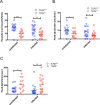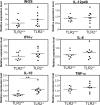Involvement of Toll-like receptor 2 in the cerebral immune response and behavioral changes caused by latent Toxoplasma infection in mice
- PMID: 31404078
- PMCID: PMC6690529
- DOI: 10.1371/journal.pone.0220560
Involvement of Toll-like receptor 2 in the cerebral immune response and behavioral changes caused by latent Toxoplasma infection in mice
Abstract
Subacute and chronic infections with the intracellular protozoan parasite Toxoplasma gondii are associated with an increased risk of psychiatric diseases like schizophrenia. However, little is known about the mechanisms involved in T. gondii-induced neuronal disorders. Recently, we reported that Toll-like receptor 2 (TLR2) was required to initiate the innate immune response in cultured mouse brain cells. However, how TLR2 contributes to latent infection with T. gondii remains unclear. Therefore, we examined the role of TLR2 in brain pathology and behavior using wild-type (TLR2+/+) and TLR2-deficient (TLR2-/-) mice. The behavioral analyses showed that TLR2 deficiency increased the anxiety state of the uninfected and infected animals alike, and TLR2 deficiency showed no relationship with the infection. In the contextual and cued fear-conditioning tests, T. gondii infection decreased the mouse freezing reaction while TLR2 deficiency increased it, but there was no interaction between the two factors. Our histopathological analysis showed that the TLR2+/+ and TLR2-/- mice had similar brain lesions at 30 days post infection (dpi) with T. gondii. Higher numbers of parasites were detected in the brains of the TLR2-/- mice than in those from the TLR2+/+ mice at 30 dpi, but not at 7 and 14 dpi. No significant differences were observed in the proinflammatory gene expression levels in the TLR2+/+ and TLR2-/- mice. Therefore, it appears that TLR2 signaling in the brain might contribute to the control of parasite growth, but not to brain pathology or the impaired fear memory response induced by infection with T. gondii.
Conflict of interest statement
The authors have declared that no competing interests exist.
Figures





Similar articles
-
TLR2 as an essential molecule for protective immunity against Toxoplasma gondii infection.Int Immunol. 2003 Sep;15(9):1081-7. doi: 10.1093/intimm/dxg108. Int Immunol. 2003. PMID: 12917260
-
Roles of the small intestine for induction of toll-like receptor 4-mediated innate resistance in naturally acquired murine toxoplasmosis.Int Immunol. 2006 Dec;18(12):1655-62. doi: 10.1093/intimm/dxl099. Epub 2006 Oct 11. Int Immunol. 2006. PMID: 17035347
-
Activation of TLR2 and TLR4 by glycosylphosphatidylinositols derived from Toxoplasma gondii.J Immunol. 2007 Jul 15;179(2):1129-37. doi: 10.4049/jimmunol.179.2.1129. J Immunol. 2007. PMID: 17617606
-
Transcriptional profiling of Toll-like receptor 2-deficient primary murine brain cells during Toxoplasma gondii infection.PLoS One. 2017 Nov 14;12(11):e0187703. doi: 10.1371/journal.pone.0187703. eCollection 2017. PLoS One. 2017. PMID: 29136637 Free PMC article.
-
[Toxoplasma gondii: a potential role in the genesis of psychiatric disorders].Encephale. 2013 Feb;39(1):38-43. doi: 10.1016/j.encep.2012.06.014. Epub 2012 Aug 21. Encephale. 2013. PMID: 23095600 Review. French.
Cited by
-
Association between Suicide and Toxoplasma gondii Seropositivity.Pathogens. 2021 Aug 27;10(9):1094. doi: 10.3390/pathogens10091094. Pathogens. 2021. PMID: 34578127 Free PMC article.
-
The role of IFN-γ-mediated host immune responses in monitoring and the elimination of Toxoplasma gondii infection.Int Immunol. 2024 Apr 3;36(5):199-210. doi: 10.1093/intimm/dxae001. Int Immunol. 2024. PMID: 38175650 Free PMC article. Review.
-
Counting the Toll of Inflammation on Schizophrenia-A Potential Role for Toll-like Receptors.Biomolecules. 2023 Jul 30;13(8):1188. doi: 10.3390/biom13081188. Biomolecules. 2023. PMID: 37627253 Free PMC article. Review.
-
Toll-Like Receptor 2 is Involved in Abnormal Pregnancy in Mice Infected with Toxoplasma gondii During Late Pregnancy.Front Microbiol. 2021 Oct 5;12:741104. doi: 10.3389/fmicb.2021.741104. eCollection 2021. Front Microbiol. 2021. PMID: 34675905 Free PMC article.
-
Cerebral toxoplasmosis in HIV-infected patients: a review.Pathog Glob Health. 2023 Feb;117(1):14-23. doi: 10.1080/20477724.2022.2083977. Epub 2022 Jun 11. Pathog Glob Health. 2023. PMID: 35694771 Free PMC article. Review.
References
-
- Chen M, Aosai F, Norose K, Mun H-S, Takeuchi O, Akira S, et al. Involvement of MyD88 in Host Defense and the Down-Regulation of Anti-Heat Shock Protein 70 Autoantibody Formation by MyD88 in Toxoplasma gondii-Infected Mice. J Parasitol. 2002;88: 1017–1019. 10.1645/0022-3395(2002)088[1017:IOMIHD]2.0.CO;2 - DOI - PubMed
-
- Debierre-Grockiego F, Campos M a, Azzouz N, Schmidt J, Bieker U, Resende MG, et al. Activation of TLR2 and TLR4 by glycosylphosphatidylinositols derived from Toxoplasma gondii. J Immunol Baltim Md 1950. 2007;179: 1129–37. - PubMed
Publication types
MeSH terms
Substances
LinkOut - more resources
Full Text Sources
Molecular Biology Databases

